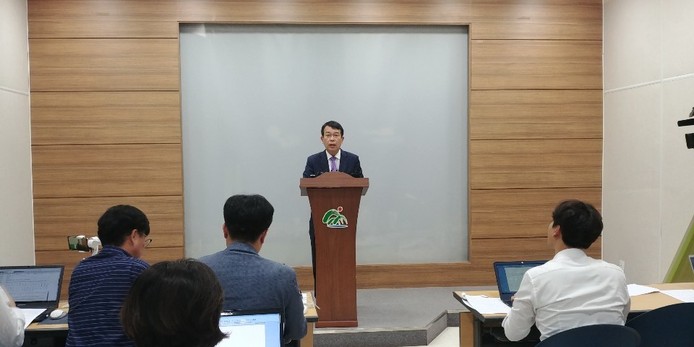 |
|
Kim Jong-dae, a lawmaker with the Justice Party, promotes the development of South Korea’s aircraft maintenance industry at the North Chungcheong Provincial Office on June 4. (Oh Yoon-jo, Cheongju correspondent)
|
S. Korean fighter jets currently repaired by Japanese technicians
A South Korean politician has called for the government, the military, and the private sector to all take part in developing the aircraft maintenance, repair and overhaul industry to service both civilian and military aircraft, including the F-35 fighter, a strategic asset of the state. “The government should take the lead in the promotion of the aircraft maintenance, repair, and overhaul industry with cooperation from the military and the private sector so that we can prevent more than 2 trillion won (US$1.7 billion) of our national wealth from going overseas every year. Since basically the same personnel, technology, and facilities are used in repairs of civilian and military aircraft, the ideal scenario is for this industry to integrate the military and the private sector,” said Justice Party lawmaker Rep. Kim Jong-dae during a press conference at the North Chungcheong Provincial Office on June 4. Kim identified Cheongju International Airport as a potential hub for the aircraft maintenance industry. “Cheongju has an international airport and the Aeropolis industrial park, which is large enough to cover 60 football fields. This is the most appropriate site in the country for the aviation maintenance industry: it’s the home base of the F-35, a national strategic asset, and a low-cost carrier is about to launch with Cheongju International Airport as its headquarters,” Kim said. On Mar. 29, two F-35 fighters were deployed to an air base at Cheongju, with more expected in the future. Kim, who is regarded as a strategy expert, also argued that South Korea should perform its own maintenance on the F-35 fighter, a strategic asset. “While two F-35 fighters are currently deployed at Cheongju, the fact is that maintenance is taking place in Japan because of a disagreement with the US fighter manufacturer about the issue of technology transfer. As the number of fighters increases to 40 over the next four or five years and then to 60 after that, we should gain permission to handle the maintenance ourselves. We need to do that so we can acquire security autonomy and not be so dependent upon Japan,” he said. Kim also argued that establishing an aircraft maintenance industry in South Korea could keep billions of dollars of the national wealth from being drained out of the country each year and could create good jobs. “Currently, South Korea has 430 fighters, 600 helicopters, 100 support craft, and 426 civilian aircraft, which produced 5.1 trillion won (US$4.32 billion) in aircraft maintenance revenue last year. But 2.26 trillion won (US$1.91 billion) worth of that maintenance — 1.78 trillion won (US$1.51 billion) for civilian aircraft and 480 billion won (US$406.4 million) for military aircraft — took place overseas. If a government-led aircraft maintenance industry can be established, it could prevent an outflow of national wealth and create around 10,000 jobs,” he said. On May 26-29, Kim visited aircraft maintenance companies and the Government Technology Agency in Singapore. On July 1, he plans to hold a debate at the National Assembly titled “A Plan for Innovative Growth: Promoting Civilian Integration in Military Maintenance, Repair, and Overhaul.” By Oh Yoon-joo, Cheongju correspondent Please direct comments or questions to [english@hani.co.kr]





